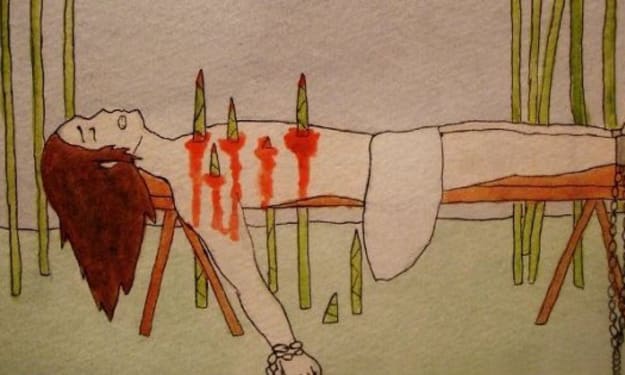Content warning
This story may contain sensitive material or discuss topics that some readers may find distressing. Reader discretion is advised. The views and opinions expressed in this story are those of the author and do not necessarily reflect the official policy or position of Vocal.
A Public Spectacle of Justice: The Hanging of Majid and Hossein Kavousifar
Is this a fair judgment?

In 2007, the world witnessed a dramatic and controversial display of justice in Tehran, Iran. Majid Kavousifar and his nephew, Hossein Kavousifar, were publicly hanged in front of the Ershad judiciary complex. Their crime was the assassination of Judge Hassan Moghaddas, a prominent figure in Iran’s judiciary, whom they shot dead in his car in 2005. This blog post delves into the events leading up to the execution, the context of their crime, and the broader implications of this public execution in Iran.
The Assassination of Judge Hassan Moghaddas
Judge Hassan Moghaddas was known for his hardline stance and his role in prosecuting political dissidents and criminals under Iran's strict Islamic laws. On August 2, 2005, Moghaddas was shot dead in his car outside the Ershad judiciary complex in Tehran. The assassination sent shockwaves through the Iranian judiciary and the public, highlighting the deep tensions within the country's political and legal landscape.
The perpetrators, Majid Kavousifar and his nephew Hossein Kavousifar, were quickly identified and apprehended. Their motivations for the assassination were rooted in a mix of personal vendetta and broader discontent with the judicial system. Majid Kavousifar had a history of legal troubles and grievances against the judiciary, and his actions were seen as a desperate and violent protest against what he perceived as an unjust system.
The Trial and Sentencing
The trial of Majid and Hossein Kavousifar was swift and garnered significant media attention. Both men confessed to the assassination, with Majid taking the primary responsibility. The Iranian judiciary, eager to demonstrate its control and the consequences of attacking its members, sentenced both men to death by hanging.
The public nature of their execution was intended to serve as a powerful deterrent. By staging the execution in front of the very judiciary complex where the assassination took place, the authorities aimed to send a clear message about the sanctity of the judiciary and the severe repercussions for those who dared to challenge it.
The Execution: A Public Spectacle
On August 2, 2007, exactly two years after the assassination, Majid and Hossein Kavousifar were led to the gallows in front of a large crowd that had gathered outside the Ershad judiciary complex. The date and location were deliberately chosen to mark the anniversary of Judge Moghaddas's death and to reinforce the message of retributive justice.
The execution was a highly choreographed event, with both men being publicly paraded and then hanged from cranes, a common method of execution in Iran. The images of the hanging were widely circulated in Iranian media and internationally, sparking a range of reactions from horror to approval.
Reactions and Implications
The public execution of Majid and Hossein Kavousifar elicited mixed reactions within Iran and beyond. Supporters of the Iranian government and judiciary saw it as a necessary and justified response to a heinous crime. They argued that the public nature of the execution was crucial for maintaining law and order and deterring future attacks on judicial figures.
Critics, however, condemned the execution as a barbaric and archaic practice that violated basic human rights. International human rights organizations decried the use of public executions, arguing that they constituted cruel and inhumane punishment. They also pointed out that such spectacles served to instill fear rather than promote genuine justice or rehabilitation.
The execution also highlighted the broader issues within Iran's judicial system, including the lack of due process and the harsh punishments meted out for a wide range of offenses. The case of the Kavousifars underscored the deep-seated grievances and tensions that many Iranians felt towards the judiciary and the government.
The Broader Context of Public Executions in Iran
Public executions have a long history in Iran, serving as a tool for both punishment and deterrence. They are often used for crimes deemed particularly severe, such as murder, rape, and drug trafficking. The Iranian government defends these practices as being rooted in Islamic law and necessary for maintaining social order.
However, the international community and human rights advocates have repeatedly called on Iran to abolish public executions and to adopt more humane methods of punishment. They argue that public executions do not effectively deter crime and instead perpetuate a cycle of violence and fear.
Reflecting on Justice and Human Rights
The case of Majid and Hossein Kavousifar forces us to confront difficult questions about justice, punishment, and human rights. While their crime was undeniably severe, the manner of their execution raises concerns about the ethics and efficacy of public executions as a form of justice.
In a broader sense, the execution underscores the challenges facing Iran as it grapples with balancing traditional legal practices with modern human rights standards. The tension between upholding law and order and ensuring fair and humane treatment for all citizens remains a contentious issue within the country.
Conclusion
The public hanging of Majid and Hossein Kavousifar in 2007 remains a stark reminder of the harsh realities of justice in Iran. Their execution, carried out in front of the Ershad judiciary complex where they had assassinated Judge Hassan Moghaddas, was intended to serve as a powerful deterrent and a reaffirmation of the judiciary's authority. However, it also sparked widespread debate and criticism, highlighting the ongoing struggle to reconcile traditional practices with modern human rights principles. As we reflect on this case, it is essential to continue advocating for justice systems that prioritize fairness, humanity, and the protection of basic human rights.
About the Creator
Enjoyed the story? Support the Creator.
Subscribe for free to receive all their stories in your feed. You could also pledge your support or give them a one-off tip, letting them know you appreciate their work.






Comments
There are no comments for this story
Be the first to respond and start the conversation.